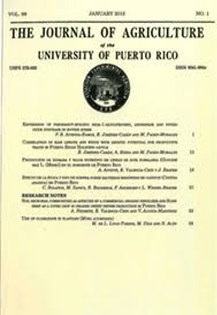Abstract
Pineapple [Ananas comosus (L.) Mere] is an important fruit crop cultivated in many tropical countries. This fruit crop requires large amounts of nitrogen (N) and potassium (K) to maximize yield. Although pineapple has low water requirements, extended drought can affect yield. Two experiments were conducted to study the effects of fertilizer application methods and drip irrigation management on pineapple yields. Pineapple cultivars MD-2 and Cabezona were planted at Isabela and Lajas, Puerto Rico, respectively. Fertilizer and irrigation treatments included: i) Controlapplication of 896 kg/ha of a granular fertilizer (12-6-10-3) at two, five and nine months after planting; ii) FS-R- application of 150-150-120-45 kg/ha at planting plus 20 foliar applications of urea and potassium sulfate (50 kg/ha) every three weeks, rainfed; iii) FS-DI- application of 150-150-120-45 kg/ha at planting plus 20 foliar applications of urea and potassium sulfate (50 kg/ha), drip irrigation applied every three weeks; iv) FERT- application of 150-150-120-45 kg/ha at planting, but urea and potassium sulfate (50 kg/ha) were applied throughout fertigation; and v) CRF- same amount of nutrients as FS-R but N was applied as a controlled release fertilizer every six months. At Isabela, treatment FS-R produced the highest fruit weight (2.5 kg per fruit) and 1.5% of N in tissue, but did not differ significantly from FS-DI and CRF. Plants under CRF registered the highest Brix (15.8°). Although foliar fertilizer tended to produce higher yields, controlled release fertilizer is recommended because it eliminates the need for frequent foliar application without compromising yield.

